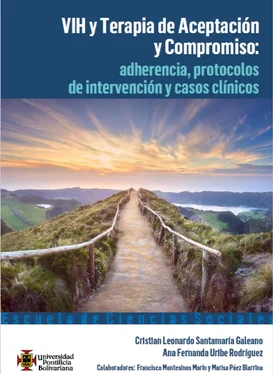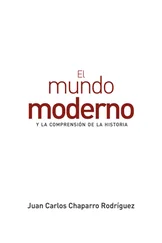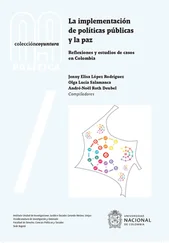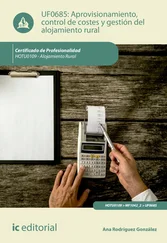ONUSIDA (2008). Reducir el estigma y la discriminación por el VIH: una parte fundamental de los programas nacionales del sida. Recuperado de http://data.unaids.org/pub/report/2009/jc1521_stigmatisation_es.pdf
Organización de las Naciones Unidas (ONU, 2004). Cómo se transmite y cómo no se transmite el VIH. Recuperado de http://portal.unesco.org/education/es/files/39090/11483803965Facts_SP_FRESH_1.pdf/Facts_SP_FRESH_1.pdfOrganización Mundial de la Salud (OMS, 2016). VIH/SIDA. Recuperado de http://www.who.int/mediacentre/factsheets/fs360/es/
Organización Mundial de la Salud OMS (2019). HIV/AIDS. Data and statistics. Recuperado de https://www.who.int/hiv/data/en/
Organización Panamericana de la Salud (2003). Comprensión y respuesta al estigma y a la discriminación por el VIH/SIDA en el sector salud. Recuperado de http://www1.paho.org/spanish/ad/fch/ai/Stigma_report_spanish.pdf?ua=1
Ospina, S. (2006). Diagnóstico de la infección por el virus de la inmunodeficiencia humana. Revista de la Asociación Colombiana de Infectología, 10 (4), 273-278.
Peterson, D., Swindells, S., Mohr, J., Brester, M., Vergis, E., Squier, C. et al. (2000). Adherence to protease inhibitor therapy and outcomes in patients with HIV infection. Annals of Internal Medicine, 133 (1), 21-30.
Programa de Apoyo a la Reforma a la Salud (2010). Guía para el manejo del VIH/SIDA basada en la evidencia Colombia. Recuperado de https://www.minsalud.gov.co/Documentos%20y%20Publicaciones/GUIA%20PARA%20EL%20MANEJO%20DE%20VIH%20SIDA.pdf
Reeves, J. & Doms, R. (2002). Human immunodeficiency virus type 2. Journal of General Virology, 83 (6), 1253-1265.
Reina, E., Insausti, A. & San Miguel, R. (2012). Análisis de pacientes candidatos a simplificación del tratamiento antirretroviral de gran actividad a monoterapia con inhibidores de la proteasa potenciados. Tesis de Maestría en Investigación en Ciencias de la Salud, Universidad Pública de Navarra, España.
Richards, D. (2011). Prevalence and clinical course of depression: a review. Clinical psychology review, 31(7), 1117-1125.
Rodríguez, M., Pulido, S., Amaya, A., Garavito, I. & Salazar, M. (2007). Factores psicosociales asociados a la infección por VIH/SIDA en pacientes residentes de la ciudad de Bogotá D.C. Cuadernos Hispanoamericanos de Psicología, 7 (1), 59-68.
Ross, M., McCurdy, S., Kilonzo, G., Williams, M. & Leshabari, M. (2008). Drug use careers and blood-borne pathogen risk behavior in male and female Tanzanian heroin injectors. The American Journal of Tropical Medicine and Hygiene, 79 (3), 338-343.
Rowley, J., Vander Hoom, S., & Korenromp, E. (2019). Chlamydia, gonorrhoea, trichomoniasis, and syphilis: global prevalence and incidence estimates, 2016. Bull World Health Organ. Recuperado de https://www.who.int/bulletin/online_first/BLT.18.228486.pdf?ua=1
Sánchez, C., Acevedo, J. & González, M. (2012). Factores de riesgo y métodos de transmisión de la infección por el virus de la inmunodeficiencia humana. Revista CES Salud Pública, 3(1), 28-37.
Santamaría, C. & Tapia, P. (2020). Conocimiento de VIH/sida en profesores de Petorca-Chile. I+D Revista de Investigaciones, 15(2), 44-51.
Secretaría de Salud México (2012). Manual de procedimientos estandarizados para la vigilancia epidemiológica del VIH/SIDA. Recuperado de http://www.epidemiologia.salud.gob.mx/doctos/infoepid/vig_epid_manuales/30_2012_Manual_VIH-SIDA_vFinal_1nov12.pdf
Shen, M., Hu, F., Lin, J., Hsie, S., Hung, C., Chung, C. (1998). Human immunodeficiency virus infection in have mophiliacs in Taiwan: the importance of CD4 lymphocyte count in the progression to acquired immunodeficiency syndrome. Haemophilia, 4 (2), 115-121.
Simbaqueba, J., Pantoja, C., Castiblanco, B. & Ávila, C. (2011). Voces positivas: resultados del índice de estigma en personas que viven con VIH en Colombia. Recuperado de http://www.portalsida.org/repos/INFORME_VOCES_POSITIVAS.pdf
Skinta, M., Lezama, M., Wells, G. & Dilley, J. (2014). Acceptance and Compassion-Based Group Therapy to Reduce HIV Stigma. Cognitive and Behavioral Practice, 22 (4), 481-490.
Sontag, S. (1989). El sida y sus metáforas. Madrid: Muchnik.
Springer, S. A., Chen, S., & Altice, F. (2009). Depression and symptomatic response among HIV-infected drug users enrolled in a randomized controlled trial of directly administered antiretroviral therapy. AIDS care, 21(8), 976-983.
Stutterheim, S. E., Pryor, J. B., Bos, A. E., Hoogendijk, R., Muris, P., & Schaalma, H. P. (2009). HIV-related stigma and psychological distress: the harmful effects of specific stigma manifestations in various social settings. Aids, 23(17), 2353-2357.
Tamayo-Zuluaga, B., Macías-Gil, Y., Cabrera-Orrego, R., Henao-Peláez, J. & Cardona-Arias, J. (2014). Estigma social en la atención de personas con VIH/SIDA por estudiantes y profesionales de las áreas de la salud, Medellín, Colombia. Revista de Ciencias de la Salud, 13 (1), 9-23.
Trépanier, L. L., Rourke, S. B., Bayoumi, A. M., Halman, M. H., Krzyzanowski, S., & Power, C. (2005). The impact of neuropsychological impairment and depression on health-related quality of life in HIV-infection. Journal of Clinical and Experimental Neuropsychology, 27(1), 1-15.
Treisman, G., & Angelino, A. (2007). Interrelation between psychiatric disorders and the prevention and treatment of HIV infection. Clinical Infectious Diseases, 45(Supplement_4), S313-S317.
Tsutsumi, A. y Izutsu, T. (2010). Quality of Life and Stigma. En Victor R. Preedy, Ronald R. Watson (Eds.), Handbook of disease burdens and quality of life measures (pp. 3490-3499). New York: Springer.
Vera-Gamboa, L. (2001). Rutas de infección por el virus de inmunodeficiencia humana inicialmente no consideradas factibles. Revista Biomédica, 12 (2), 122-129.
Visser, M. J., Neufeld, S., De Villiers, A., Makin, J. D., & Forsyth, B. W. (2008). To tell or not to tell: South African women’s disclosure of HIV status during pregnancy. AIDS care, 20(9), 1138-1145.
Weber, J., Piontkivska, H. & Quinones-Mateu, M. (2006). HIV type 1 tropism and inhibitors of viral entry: clinical implications. AIDS Reviews, 8 (2), 60-77.
Wyatt, R. & Sodroski, J. (1998). The HIV-1 envelope glycoproteins: fusogens, antigens, and immunogens. Science, 280 (5371), 1884-1888.
Watkins, C. C., & Treisman, G. J. (2012). Neuropsychiatric complications of aging with HIV. Journal of neurovirology, 18(4), 277-290.
Zheng, Y., Lovsin, N. & Peterlin, B. (2005). Newly identified host factors modulate HIV replication. Immunology Letters, 97 (2), 225-234.
Конец ознакомительного фрагмента.
Текст предоставлен ООО «ЛитРес».
Прочитайте эту книгу целиком, купив полную легальную версию на ЛитРес.
Безопасно оплатить книгу можно банковской картой Visa, MasterCard, Maestro, со счета мобильного телефона, с платежного терминала, в салоне МТС или Связной, через PayPal, WebMoney, Яндекс.Деньги, QIWI Кошелек, бонусными картами или другим удобным Вам способом.












